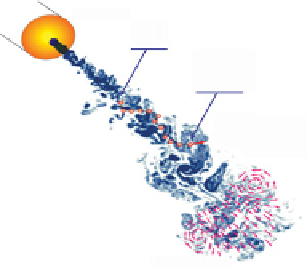Geoscience Reference
In-Depth Information
measurements. Several factors have contributed to what
wecancallthe
Lagrangian revolution
: (i) The importance
of Lagrangian approaches for modeling. The relevance
of a Lagrangian description of the dynamics of a fluid
in the context of mixing and transport phenomena has
been realized since
Taylor
[1922] and
Richardson
[1926]
(in particular for atmospheric and oceanic flows). It is
now essential for the study of dispersion (pollutants, for
instance). Modern stochastic models are best developed
in the Lagrangian domain. (ii) Technological progress
have given access to the ultrafast recording and process-
ing performance required for Lagrangian tracking. This
led for instance to the first measurements of acceleration
of fluid particles in turbulent flows over a decade ago [
Voth
et al.
, 2002;
Mordant et al.
, 2001]. We detail in the follow-
ing sections some of the latest measurement techniques
used in state-of-the-art laboratory experiments. We shall
begin with optical techniques (Lagrangian tracking and
extended laser Doppler velocimetry (ELDV)) before mov-
ing to acoustical ones (Lagrangian tracking and vorticity
measurement). We close this chapter with an introduc-
tion to instrumented particles. As will be illustrated below,
some of these techniques have already proven their rele-
vance to investigate model flows with geophysical motiva-
tions (rotating fluids, stratified flows, turbulent transport
phenomena, etc.).
Jet nozzle
r
→
→
r
(
t
)
→→
→
υ
L
(
t
,
r
0
) =
r
(
t
)
→ →
υ
E
(
r
,
t
)
Figure 15.1.
Eulerian versus Lagrangian description of a flow.
In the Eulerian framework the flow is described in terms of
the velocity field, while in the Lagrangian framework it
is
characterized from the trajectories of fluid tracers.
general instantaneous temporal fluctuations, in statisti-
cally stationary conditions, the time
t
is generally consid-
ered as a parameter which helps build ensemble averages
by repeating the measurement (if the system is not statis-
tically stationary, then time
t
becomes an actual variable
of the problem which accounts for nonstationary effects).
Eulerian measurements have for long been the most
widely used in experimental fluid mechanics: Hot-wire
measurements, particle image velocimetry (PIV), and laser
Doppler velocimetry (LDV) are classical techniques. In
the Lagrangian approach, instead of probing the flow at
given fixed points
15.2. OPTICAL TECHNIQUES
r
(where fluid particles constantly pass),
and velocity is measured along the path of given fluid ele-
ments which are tagged and tracked individually. In this
representation, the velocity
15.2.1. Particle Tracking
An important advance in Lagrangian measurements
was done in 1997 by
Virant and Dracos
[1997], who devel-
oped 3D particle tracking velocimetry (PTV) based on
the direct imaging of small particles seeding the flow.
They used simultaneously four video cameras at a rate
of 25 fps to access the 3D trajectories of several hun-
dreds of particles at once.
Ott and Mann
[2000] developed
a similar technique to study relative dispersion of fluid
particles. In those two pioneering experiments, because of
the low frame rate, particle dynamics could be resolved
only for flows at moderate Reynolds numbers (Re
<
4000
typically).
LaPorta et al.
[2001] used silicon strip detec-
tors (initially developed for high-energy particle detection)
at a frame rate up to 70 kHz, allowing the first fully
resolved Lagrangian optical tracking measurements at
Reynolds numbers approaching 10
5
. However, only one
particle at a time could be tracked with the silicon strip
detectors. Subsequently,
Bourgoin et al.
[2006] developed
a high-resolution 3DPTV facility similar to that of Virant
and Dracos and Ott and Mann, but using ultrafast cam-
eras at a repetition rate of 27 kHz, allowing the tracking
of several hundred of particles in high-Reynolds-number
r
0
)
changes in the course
of time
t
while space coordinates simply parametrize the
initial position
v
L
(t
,
r
0
of the fluid particle under investiga-
tion. In statistically homogeneous conditions,
r
0
is mainly
a parameter which is considered either to improve sta-
tistical convergence by simultaneously tracking several
particles with different initial separations or to address
multiparticle problems such as mixing and dispersion.
Eulerian measurements have prevailed in experimental
fluid mechanics for decades. Recent progress in Eulerian
measurements mainly concern the improvement of PIV
systems, which are now commonly available in 3D-3C
configuration (where the three components of the veloc-
ity field are measured in a full 3D volume of the flow,
for instance, using tomographic reconstruction), with an
increased repetition rate (due to the newest high-speed
camera technologies) giving access to time-resolved mea-
surements.
On the other hand, Lagrangian measurements have
now been developed to the point where Lagrangian par-
ticle tracking is among the most accurate fluid dynamics

















